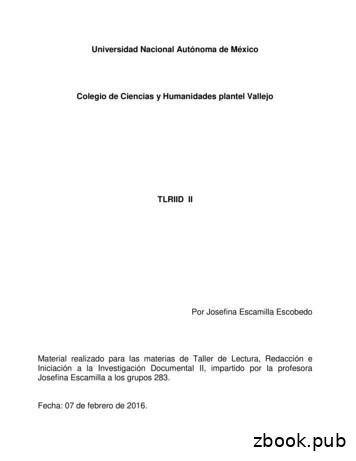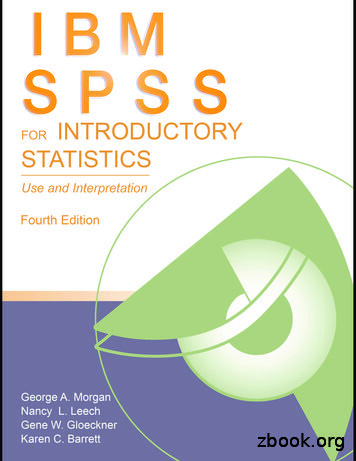Statistics And Computing - Academia.dk
Statistics and ComputingSeries Editors:J. ChambersD. HandW. Härdle
Statistics and ComputingBrusco/Stahl: Branch and Bound Applications in CombinatorialData AnalysisChambers: Software for Data Analysis: Programming with RDalgaard: Introductory Statistics with R, 2nd ed.Gentle: Elements of Computational StatisticsGentle: Numerical Linear Algebra for Applications in StatisticsGentle: Random Number Generation and MonteCarlo Methods, 2nd ed.Härdle/Klinke/Turlach: XploRe: An Interactive StatisticalComputing EnvironmentHörmann/Leydold/Derflinger: Automatic Nonuniform RandomVariate GenerationKrause/Olson: The Basics of S-PLUS, 4th ed.Lange: Numerical Analysis for StatisticiansLemmon/Schafer: Developing Statistical Software in Fortran 95Loader: Local Regression and LikelihoodMarasinghe/Kennedy: SAS for Data Analysis: IntermediateStatistical MethodsÓ Ruanaidh/Fitzgerald: Numerical Bayesian Methods Applied toSignal ProcessingPannatier: VARIOWIN: Software for Spatial Data Analysis in 2DPinheiro/Bates: Mixed-Effects Models in S and S-PLUSUnwin/Theus/Hofmann: Graphics of Large Datasets:Visualizing a MillionVenables/Ripley: Modern Applied Statistics with S, 4th ed.Venables/Ripley: S ProgrammingWilkinson: The Grammar of Graphics, 2nd ed.
Peter DalgaardIntroductory Statistics with RSecond Edition123
Peter DalgaardDepartment of BiostatisticsUniversity of CopenhagenDenmarkp.dalgaard@biostat.ku.dkISSN: 1431-8784ISBN: 978-0-387-79053-4DOI: 10.1007/978-0-387-79054-1e-ISBN: 978-0-387-79054-1Library of Congress Control Number: 2008932040c 2008 Springer Science Business Media, LLC All rights reserved. This work may not be translated or copied in whole or in part without the writtenpermission of the publisher (Springer Science Business Media, LLC, 233 Spring Street, New York,NY 10013, USA), except for brief excerpts in connection with reviews or scholarly analysis. Usein connection with any form of information storage and retrieval, electronic adaptation, computersoftware, or by similar or dissimilar methodology now known or hereafter developed is forbidden.The use in this publication of trade names, trademarks, service marks, and similar terms, even if theyare not identified as such, is not to be taken as an expression of opinion as to whether or not they aresubject to proprietary rights.Printed on acid-free paperspringer.com
To Grete, for putting up with me for so long
PrefaceR is a statistical computer program made available through the Internetunder the General Public License (GPL). That is, it is supplied with a license that allows you to use it freely, distribute it, or even sell it, as long asthe receiver has the same rights and the source code is freely available. Itexists for Microsoft Windows XP or later, for a variety of Unix and Linuxplatforms, and for Apple Macintosh OS X.R provides an environment in which you can perform statistical analysisand produce graphics. It is actually a complete programming language,although that is only marginally described in this book. Here we contentourselves with learning the elementary concepts and seeing a number ofcookbook examples.R is designed in such a way that it is always possible to do furthercomputations on the results of a statistical procedure. Furthermore, thedesign for graphical presentation of data allows both no-nonsense methods, for example plot(x,y), and the possibility of fine-grained controlof the output’s appearance. The fact that R is based on a formal computerlanguage gives it tremendous flexibility. Other systems present simplerinterfaces in terms of menus and forms, but often the apparent userfriendliness turns into a hindrance in the longer run. Although elementarystatistics is often presented as a collection of fixed procedures, analysisof moderately complex data requires ad hoc statistical model building,which makes the added flexibility of R highly desirable.
viiiPrefaceR owes its name to typical Internet humour. You may be familiar withthe programming language C (whose name is a story in itself). Inspiredby this, Becker and Chambers chose in the early 1980s to call their newlydeveloped statistical programming language S. This language was furtherdeveloped into the commercial product S-PLUS, which by the end of thedecade was in widespread use among statisticians of all kinds. Ross Ihakaand Robert Gentleman from the University of Auckland, New Zealand,chose to write a reduced version of S for teaching purposes, and what wasmore natural than choosing the immediately preceding letter? Ross’ andRobert’s initials may also have played a role.In 1995, Martin Maechler persuaded Ross and Robert to release the sourcecode for R under the GPL. This coincided with the upsurge in Open Sourcesoftware spurred by the Linux system. R soon turned out to fill a gap forpeople like me who intended to use Linux for statistical computing buthad no statistical package available at the time. A mailing list was set upfor the communication of bug reports and discussions of the developmentof R.In August 1997, I was invited to join an extended international core teamwhose members collaborate via the Internet and that has controlled thedevelopment of R since then. The core team was subsequently expandedseveral times and currently includes 19 members. On February 29, 2000,version 1.0.0 was released. As of this writing, the current version is 2.6.2.This book was originally based upon a set of notes developed for thecourse in Basic Statistics for Health Researchers at the Faculty of HealthSciences of the University of Copenhagen. The course had a primary target of students for the Ph.D. degree in medicine. However, the materialhas been substantially revised, and I hope that it will be useful for a largeraudience, although some biostatistical bias remains, particularly in thechoice of examples.In later years, the course in Statistical Practice in Epidemiology, which hasbeen held yearly in Tartu, Estonia, has been a major source of inspirationand experience in introducing young statisticians and epidemiologists toR.This book is not a manual for R. The idea is to introduce a number of basicconcepts and techniques that should allow the reader to get started withpractical statistics.In terms of the practical methods, the book covers a reasonable curriculumfor first-year students of theoretical statistics as well as for engineeringstudents. These groups will eventually need to go further and studymore complex models as well as general techniques involving actualprogramming in the R language.
PrefaceixFor fields where elementary statistics is taught mainly as a tool, the bookgoes somewhat further than what is commonly taught at the undergraduate level. Multiple regression methods or analysis of multifactorialexperiments are rarely taught at that level but may quickly become essential for practical research. I have collected the simpler methods near thebeginning to make the book readable also at the elementary level. However, in order to keep technical material together, Chapters 1 and 2 doinclude material that some readers will want to skip.The book is thus intended to be useful for several groups, but I will notpretend that it can stand alone for any of them. I have included brieftheoretical sections in connection with the various methods, but morethan as teaching material, these should serve as reminders or perhaps asappetizers for readers who are new to the world of statistics.Notes on the 2nd editionThe original first chapter was expanded and broken into two chapters,and a chapter on more advanced data handling tasks was inserted afterthe coverage of simpler statistical methods. There are also two new chapters on statistical methodology, covering Poisson regression and nonlinearcurve fitting, and a few items have been added to the section on descriptive statistics. The original methodological chapters have been quiteminimally revised, mainly to ensure that the text matches the actual output of the current version of R. The exercises have been revised, ands
Statistics and Computing Brusco/Stahl: Branch and Bound Applications in Combinatorial Data Analysis Chambers: Software for Data Analysis: Programming with R Dalgaard: Introductory Statistics with R, 2nd ed. Gentle: Elements of Computational Statistics Gentle: Numerical Linear Algebra for Applications in Statistics Gentle: Random Number Generation and Monte Carlo
LECTURA DE NOVELAS Y POEMAS: CONFLICTOS HUMANOS. Objetivo: Ampliará su experiencia de vida, a través del análisis y discusión de textos literarios que . La Real Academia Española, la Academia Colombiana de la Lengua, la Academia Ecuatoriana de la Lengua, la Academia Mexicana de la Lengua, la Academia Salvadoreña de la Lengua, la .
Cloud Computing J.B.I.E.T Page 5 Computing Paradigm Distinctions . The high-technology community has argued for many years about the precise definitions of centralized computing, parallel computing, distributed computing, and cloud computing. In general, distributed computing is the opposite of centralized computing.
distributed. Some authors consider cloud computing to be a form of utility computing or service computing. Ubiquitous computing refers to computing with pervasive devices at any place and time using wired or wireless communication. Internet computing is even broader and covers all computing paradigms over the Internet.
academia militar das agulhas negras academia real militar (1811) curso de ciÊncias militares luiz eduardo solano silva a capacidade operacional das viaturas blindadas de
Academia Colombiana Comision de Lexicografia Academia Colombiana Comision de Lexicografia. Breve Diccionario de ColombianismosBogotá CO: Jorge Plazas S., 1975. 246 [2] p. Rústica - Libro ES. CASTELLANO - DICCIONARIOS 463 --- Solicitar por: CCB-0014; Academia Boliviana de la Historia
Chapter 10 Cloud Computing: A Paradigm Shift 118 119 The Business Values of Cloud Computing Cost savings was the initial selling point of cloud computing. Cloud computing changes the way organisations think about IT costs. Advocates of cloud computing suggest that cloud computing will result in cost savings through
Statistics Student Version can do all of the statistics in this book. IBM SPSS Statistics GradPack includes the SPSS Base modules as well as advanced statistics, which enable you to do all the statistics in this book plus those in our IBM SPSS for Intermediate Statistics book (Leech et al., in press) and many others. Goals of This Book
ASTM D 4255 In-Plane Shear Strength / Modulus (Rail Shear) ASTM D 4442 Moisture Content Measurement ASTM D 4585 Controlled Condenstaion Conditioning ASTM D 5229 Moisture Absorption ASTM D 5379 Shear Properties (V-Notch) ASTM D 5420 Gardner Drop Impact Test ASTM D 5467 Skin Compression by Beam Flexure ASTM D 5628 Drop Impact Test ASTM D 570 Water Absorption ASTM D 5766 Tensile Strength, Open .























